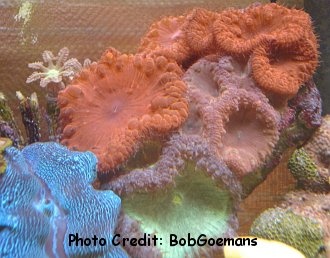
By Bob Goemans

Likely Reef Tank Suitable
Likely Fish-Only Tank Suitable
Range: Indo-West Pacific Ocean: Red Sea to the South China Sea and Southern Japan, and south to Australia.
Natural Environment: Inhabits lower reef slopes and usually seen in turbid waters. Even though it has a wide distribution in the wild, it is infrequently found and often difficult to locate in murky waters.
General Husbandry: Have fleshy polyps with a diameter that can approach 4 - 5 inches (10 - 12.5 cm). Forms a more mound-like structure, similar to mushroom corals, where its separate corallites extend from a common center. The colony increases in size by asexual budding of the marginal polyps. This differs from the only other species in the genus, i.e., B. merleti, which have much smaller polyps, about one-third the diameter, with each individual polyp forming at the ends of tubular structures that extend outward from a common base.
Since this very hardy, non-aggressive coral originates in turbid waters and at lower light levels, it is better to locate it in the aquarium in areas receiving low to moderate water movement and low light. Too much water movement and light will inhibit growth! Side areas of the aquarium or rocks may make good location areas.
Keep in mind the possible level of aggression from other corals as they can easily damage this species, even mushroom corals can damage this species! Provide sufficient distance between it and other corals.
Can be handfed when feeding tentacles are displayed by directly dosing the polyps with meaty foodstuffs, e.g., fortified brine shrimp, mysis, products containing Cyclop-eeze, and/or other marine finely diced/graded meaty foods.
By simply separating existing corallites, a specimen can easily be propagated. And should note, Blastomussa specimens are not often seen in the trade, and when available, their polyps are usually brownish, or either brown or red surrounding a central green area. The specimen pictured here, photographed in my aquarium, is exceptionally rare in my experience, as it has three differently colored polyps, all existing on the same structure.
This is a hardy, disease resistant coral, and fairly uncommon in the trade.
Taxonomy:
Kingdom: Animalia
Phylum: Cnidaria
Class: Anthozoa
Subclass: Hexacorallia
Order: Scleractinia
Family: Mussidae
Genus: Blastomussa
FYI: Cultured frags widely available.
When purchasing a specimen with highly inflated flesh, do not remove it from the water as the weight of the water in the flesh may damage or tear the flesh. Gently shake the specimen and allow the flesh to retract somewhat before removing.
Experience Level: Beginner
Diet: Photosynthetic/Plankton feeder
Temperament: Peaceful
Aquarium Environment: Reef or fish-only aquarium
Coral Safe: Yes
Fish Safe: Yes
Invertebrate Safe: Yes
Acclimation Time: 30 minutes+
Aquarium Hardiness: Hardy
Calcium (Ca): 380 - 430 mg/l
Alkalinity: 2.5 - 3.0 meq/l
Phosphate (PO4): <0.05 mg/l
Magnesium (Mg): approx. 1350 mg/l (relate to specific gravity)
Strontium (Sr) 8 - 10 mg/l
Temperature Range: 74 - 82°F (23 - 27°C)
Minimum Tank Size: 50 gallons
Lighting: PAR 250 - 300+
Water Movement: WM 1 - 2
Specific Gravity: 1.023 - 1.025
pH: 8.0 - 8.4
Iodine/Trace Elements Monitor/as necessary to maintain quality seawater.
